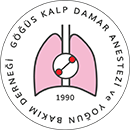

Torakotomi sonrası epidural blok ile tek doz paravertebral blok analjezisinin karşılaştırılması
Yusuf Çetin1, Nazan Atalan2, İbrahim Uğur1, Türkan Kudsioğlu2, Nihan Yapıcı2, Zuhal Aykaç31Siyami Ersek Göğüs Kalp Camar Cerrahisi Eğitim Ve Araştırma Hastanesi, Anesteziyoloji Kliniği, İstanbul2Marmara Üniversitesi Sağlık Hizmetleri Meslek Yüksekokulu, Anestezi Proğramı, İstanbul
3Marmara Üniversitesi Tıp Fakültesi, Pendik Eğitim Ve Araştırma Hastanesi, Anesteziyoloji Kliniği, İstanbul
GİRİŞ ve AMAÇ: Bu prospektif, randomize, kontrollü çalışmada, torokotomi sonrası torasik epidural analjezi (EA) ile torasik paravertebral blok analjezisinin (PA) postoperatif ağrı ve hemodinamik parametreler üzerine olan etkileri karşılaştırıldı.
YÖNTEM ve GEREÇLER: Elektif akciğer cerrahisi planlanan 11i kadın, 33ü erkek toplam 44 olgu prospektif olarak bu çalışmaya alındı. Olgular rastgele iki gruba ayrıldı. Postoperatif analjezi; EA grubunda, anestezi öncesi torakotomi için planlanan insizyon hattının bir seviye altından (T5-6 veya T67) yerleştirilen epidural katater ile ve PA grubunda, operasyon bitiminde ekstübasyon öncesi T5-T8 aralıklarından yapılan paravertebral blok ile sağlandı. EA olgularına 25 gr fentanil ile % 0.125 Bupivakain 7.5 ml bolus verildi. PA grubunda ise % 0.125 Bupivakain 25μg fentanil ile üç seviyeden toplam 15 ml tek enjeksiyonda verildi. Vizüel Analog Skala (VAS) ağrı skoru, hemodinamik değerler (ortalama kan basıncı, kalp atım hızı) ve arteriyel kan gazı değerleri postoperatif 1, 2, 3, 5, 8, 12 ve 24. saatlerde değerlendirildi.
BULGULAR: Grupların başlangıç ile postoperatif VAS skor ölçümleri arasında istatistiksel olarak anlamlı farklılık saptanmadı (p>0.05). Her iki grupta takip sürelerine göre VAS ölçümleri incelendiğinde hem epidural hem de paravertebral grupta postoperatif ilk üç saatte anlamlı bir fark yoktu (p>0,05). Her iki grupta da herhangi bir yan etki veya komplikasyon kaydedilmedi.
TARTIŞMA ve SONUÇ: Paravertebral blok; uygulama kolaylığı, yan etki ve komplikasyon oranlarının düşüklüğü ve benzer ağrı kontrolü sağlaması nedeniyle epidural bloğa iyi bir alternatif olabilir.
Comparison of epidural and single-shot paravertebral block analgesia after thoracotomy
Yusuf Çetin1, Nazan Atalan2, İbrahim Uğur1, Türkan Kudsioğlu2, Nihan Yapıcı2, Zuhal Aykaç31Siyami Ersek Thorax And Cardiovascular Surgery Training And Research Hospital, Department Of Anesthesiology, Istanbul2Marmara University Health Services Vocational School, Department Of Anesthesiology, Istanbul
3Marmara Üniversitesi Faculty Of Medicine, Pendik Training And Research Hospital, Department Of Anesthesiology, Istanbul
INTRODUCTION: In this prospective, randomized and controlled trial, postoperative analgesia and hemodynamic effects of thoracic epidural analgesia (EA) and thoracic paravertebral block analgesia (PA) after thoracotomy were compared.
METHODS: A total of 44 patient, 11 women and 33 men, who were planned to undergo elective open lung surgery, were included in this study. The cases were randomly divided into two groups. Postoperative analgesia was performed with an epidural catheter placed below the level of the incision line planned for thoracotomy (T5-6 or T67), before anesthesia in the EA group and it was performed with thoracic paravertebral block from before extubation at the end of the operation in the PA group. 25 μg of fentanyl+0.125% of bupivacaine 7.5 ml of bolus were given to the epidural space in the EA group. 0.125% bupivacaine and 25μg fentanyl were given in a total of 15 ml from three levels (T5-T8), in the PA group. Visual analogue scale (VAS) for pain, hemodynamic values and arterial blood gas values were recorded at postoperative 1,2,3,5,8,12and 24 hours.
RESULTS: There was no statistically significant difference between baseline and postoperativeVAS scores between the groups and when VAS measurements were compared according to the follow-up periods in both groups, there was no significant difference in the first three hours in both the epidural and paravertebral groups(p>0,05). There were no side effects or complications in both groups(p>0,05).
DISCUSSION AND CONCLUSION: Paravertebral block may be a good alternative to the epidural block because of ease of application, low side effects and complication rates and similar pain control.
Sorumlu Yazar: Yusuf Çetin, Türkiye
Makale Dili: Türkçe
(971 kere indirildi)














